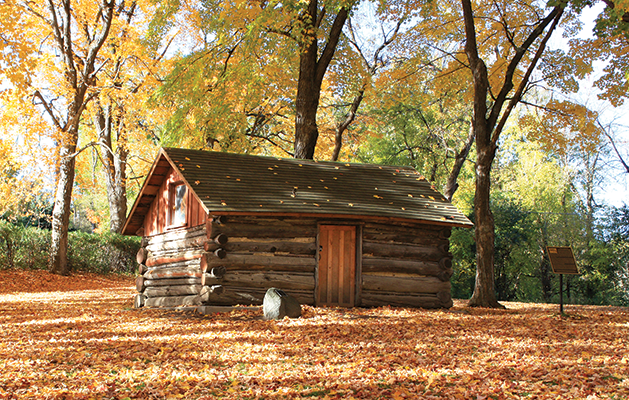
Irene Stemmer, sharp as ever at age 92, is leafing through her book, The Trapper’s Cabin of Wayzata: A Journey to Preservation, when she stops on a page near the back.
Stemmer points to three photographs of children frolicking outside the refurbished 1800s-era trapper’s cabin in Wayzata’s Shaver Park. It was moved to the southwest corner of the park (Grove Lane and Ferndale Avenue) in the fall of 2014. “They think I live there,” she says with a laugh. “These two were going up to [what they called] Irene’s cabin. They never saw anything like it before. That’s why preserving it for future generations is important.”
The cabin doesn’t actually belong to Stemmer, of course. The city of Wayzata now owns it, but Stemmer was the driving force behind saving the rustic 12-by-16-foot cabin from being bulldozed at its former location on Bushaway Road. “It’s now exactly where it should be,” says Stemmer of tree-lined Shaver Park. It's a short walk from the historic Wayzata Depot & Museum, which was built by the Great Northern Railway in 1906. “Actually, it’s better than where it was, because nobody could see it. Now people can go up to the cabin and touch it and look at it,” she says.
Stemmer’s self-published book is a firsthand account of her preservation efforts. It’s short, 44 pages with lots of photographs, and reveals much about Stemmer’s tenacity. “I wouldn’t have given up,” says the longtime Wayzata resident and former Heritage Preservation Board member. “Wayzata didn’t have a log cabin [left to display], yet we’re one of the oldest cities on the lake.”
For more than 100 years, the cabin resided on wooded, private land at 324 Bushaway Road. Seven owners came and went, but the cabin remained. That is, until a developer bought the property, planning homes.
“Half of Wayzata knew it was there,” she says. “It was upsetting to many that the cabin was going to be torn down.” So began Stemmer’s quest. After the developer agreed to donate the structure to Wayzata, she worked to persuade the city council to take it. Stemmer searched for clues on the cabin’s history, but nothing was written down. Who built the cabin and when is still a mystery. One story she heard but couldn’t prove said it was built by a St. Paul logger—who might have been a trapper, too—in 1853.
A man named Thomas Andrews built the first big house on the property in 1889. Early photos of Andrews' house show the cabin, too. It was Andrews’ grandson John Field who dubbed it the “trapper’s cabin.” “I lived with the Field family for about three months when I first came to Wayzata” in 1945, Stemmer explains. “There weren’t any places to live; you had to live in somebody’s home. I never asked a question about this cabin. But it was there.”
A state historian urged Stemmer to search for a connection between the cabin and Wayzata’s history. That link came when the cabin’s logs were found to be tamarack, once plentiful around Lake Minnetonka. Oscar E. Garrison, who founded Wayzata, built a log cabin in 1853 using tamarack wood. Settlers found the straight-growing trees ideal for cabins and fenceposts. Garrison “had written a letter that was on file at the Minnesota Historical Society that he built a cabin with tamarack,” she says. But it wasn’t until Stemmer secured $25,000 in private dollars to move and restore the cabin—it needed a new roof and logs at its base—that the city came on board. “It’s a touchy-feeling kind of thing,” she says. “You can’t look at a log cabin and not roll back in time.”
The Trapper’s Cabin is expected to be on sale at the Wayzata Depot, 402 E. Lake St., beginning this spring. For more information, call the Wayzata Historical Society at 952.473.3631.









